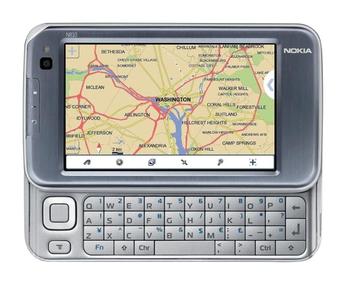New Nokia Tablet N810 with Keyboard and GPS
Nokia has just announced the latest version of its Linux-based tablet PC. The device comes with a 4.13 inch touch screen, and a full-fledged keyboard.
The N810 is the third generation Internet tablet PC by Nokia. It will be available as of November for around 450 euros. Like its predecessors, the N810 does not include wireless technology and relies on an external WLAN or mobile phone for Web use or VoIP.
The N810 includes a Mozilla Web browser with Ajax, Adobe Flash 9, the Skype VoIP solution, a camera, and a player. The device has the familiar slide-out type keyboard used by many mobile phones. New features include a GPS receiver and preinstalled maps with points-of-interest (POI), although it is currently unclear what areas the maps will cover.
Nokia 810 with slide-out keyboard and GPS receiver. Source: Nokia
The Nokia N810 uses Maemo version OS2008, the free Linux distribution for mobile devices. According to the manufacturer, users of the predecessor, N800, will be able to update to the new version. Other features provided by the new tablet include an individually configurable interface and enhanced video and audio functionality.
In future, Nokia aims to provide support for the Maemo platform to free developers and enterprises via its own Nokia Forum. The vendor speaks of 3.4 million registered users who develop mobile applications for the Symbian Series 40 and Series 60 platforms.
Mobile devices of this type, especially those that use a Linux operating system have excellent market prospects, and the market is highly competitive due to this. Just recently, CPU manufacturer ARM entered into a cooperation with six partners to work the market (see the separate news item here), and Intel is also collaborating with the company behind Ubuntu, Canonical, on a mobile platform (see the separate news item here).
Subscribe to our Linux Newsletters
Find Linux and Open Source Jobs
Subscribe to our ADMIN Newsletters
Support Our Work
Linux Magazine content is made possible with support from readers like you. Please consider contributing when you’ve found an article to be beneficial.

News
-
Manjaro 26.0 Primary Desktop Environments Default to Wayland
If you want to stick with X.Org, you'll be limited to the desktop environments you can choose.
-
Mozilla Plans to AI-ify Firefox
With a new CEO in control, Mozilla is doubling down on a strategy of trust, all the while leaning into AI.
-
Gnome Says No to AI-Generated Extensions
If you're a developer wanting to create a new Gnome extension, you'd best set aside that AI code generator, because the extension team will have none of that.
-
Parrot OS Switches to KDE Plasma Desktop
Yet another distro is making the move to the KDE Plasma desktop.
-
TUXEDO Announces Gemini 17
TUXEDO Computers has released the fourth generation of its Gemini laptop with plenty of updates.
-
Two New Distros Adopt Enlightenment
MX Moksha and AV Linux 25 join ranks with Bodhi Linux and embrace the Enlightenment desktop.
-
Solus Linux 4.8 Removes Python 2
Solus Linux 4.8 has been released with the latest Linux kernel, updated desktops, and a key removal.
-
Zorin OS 18 Hits over a Million Downloads
If you doubt Linux isn't gaining popularity, you only have to look at Zorin OS's download numbers.
-
TUXEDO Computers Scraps Snapdragon X1E-Based Laptop
Due to issues with a Snapdragon CPU, TUXEDO Computers has cancelled its plans to release a laptop based on this elite hardware.
-
Debian Unleashes Debian Libre Live
Debian Libre Live keeps your machine free of proprietary software.

